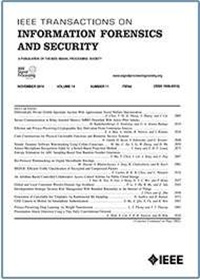基于压缩和像素域联合特征的HEVC视频对抗样本检测
IF 8
1区 计算机科学
Q1 COMPUTER SCIENCE, THEORY & METHODS
IEEE Transactions on Information Forensics and Security
Pub Date : 2024-12-12
DOI:10.1109/TIFS.2024.3516569
引用次数: 0
摘要
深度学习模型目前受到对抗性攻击的严重威胁,而对抗性检测是对抗此类攻击的有效手段。然而,现有的对抗检测技术在视频对抗帧的定位方面存在不足,导致稀疏视频对抗攻击的性能较差。本文提出了一种基于视频压缩和RGB域融合特征的视频对抗性扰动检测方法。我们的研究首先考察了在视频对抗性攻击中引入的大量非自然噪声如何严重破坏单个帧的空间结构和帧之间的运动信息。在HEVC视频编码过程中,这种破坏最终导致编码树单元(CTU)划分的不自然变化。然后将编码单元(CU)、预测单元(PU)和变换单元(TU)的位置和划分信息细致地映射到特定的值和大小上,构成视频的压缩域单元(CDU)特征。最后,利用视频的CDU特征和解码帧的RGB特征的双路径网络被用于检测视频对抗样本。进行了大量的实验来验证性能。结果表明,该方法在视频对抗检测方面优于或可与最先进的方法相媲美。本文章由计算机程序翻译,如有差异,请以英文原文为准。
HEVC Video Adversarial Samples Detection via Joint Features of Compression and Pixel Domains
Deep learning models are currently under significant threat from adversarial attacks, while adversarial detection represents an effective means of countering such assaults. However, existing adversarial detection techniques are deficient in localizing video adversarial frames, leading to poor performance on sparse video adversarial attacks. This paper presents an approach for detecting adversarial perturbations in videos based on fusion features derived from the video compression and RGB domain. Our research begins by examining how the introduction of extensive non-natural noise during video adversarial attacks severely disrupts the spatial structure of individual frames and the motion information between frames. This disruption culminates in unnatural variations in the Coding Tree Units (CTU) partitioning during the HEVC video encoding process. Then meticulously mapping the positions and partitioning information of coding units (CU), predictive units (PU), and transformation units (TU) onto specific values and sizes, constituting the video’s Compression Domain Units (CDU) features. Finally, a dual-path network utilizing both the video’s CDU features and the decoded frames RGB features is employed for detecting video adversarial samples. Extensive experiments are conducted to verify the performance. The results show that the proposed scheme outperforms or rivals the state-of-the-art methods in video adversarial detection.
求助全文
通过发布文献求助,成功后即可免费获取论文全文。
去求助
来源期刊

IEEE Transactions on Information Forensics and Security
工程技术-工程:电子与电气
CiteScore
14.40
自引率
7.40%
发文量
234
审稿时长
6.5 months
期刊介绍:
The IEEE Transactions on Information Forensics and Security covers the sciences, technologies, and applications relating to information forensics, information security, biometrics, surveillance and systems applications that incorporate these features
 求助内容:
求助内容: 应助结果提醒方式:
应助结果提醒方式:


